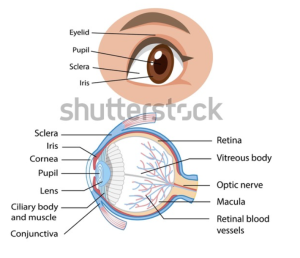CONDITIONS
What is Human Eye?
The eye is a specialized sensory organ. The eyes work like a camera. They take in light and send the information to your brain. The brain then processes this information, making the images appear so you can see them.

Interesting facts about eyes
- Your eyes can distinguish approximately 10 million different colors
- Color blindness is more predominant in men compared to women.
- The most common type of color blindness is red-green, followed by blue-yellow color blindness.
- Babies typically take around four months to develop the ability to see colors and perceive distant objects.
- Newborns don’t produce tears for around six weeks.
- Tear production decreases as we grow older.
Anatomy
The eye sits in a bony socket called the orbit, which protects it. Inside the orbit, six muscles control eye movement in different directions. Different parts of the eye include
- Iris: The colored part of the eye surrounding the pupil.
- Pupil: The dark circular opening in the center of the iris. It adjusts in size to control the amount of light entering the eye.
- Lens: Located behind the pupil. It focuses the light that comes into your eye and sends light to the back of your eye.
- Sclera: The tough, white outer layer of the eye that surrounds the iris.
- Conjunctiva: A clear, thin tissue that covers the sclera and lines the inside of your eyelids.
- Cornea: The clear, dome-shaped outermost layer at the front of the eye. It helps focus incoming light.
- Retina: The innermost layer of the eye that contains specialized cells called photoreceptors (rods and cones) that capture light and convert it into electrical signals.
- Macula: The macula is a small area within the retina that helps in central vision and lets us see fine details and perceive colors accurately.
- Optic Nerve: The nerve that carries visual information from the retina to the brain for processing.
- Vitreous Humor: A gel-like substance that fills the space between the lens and the retina, providing shape and support to the eye.
How do eyes work
- Light enters our eyes through the front part called the cornea, which acts like a window.
- The cornea bends the incoming light, making it pass through a hole called the pupil. The colored part of our eye, the iris, controls the size of the pupil.
- After passing through the pupil, the light reaches a lens inside our eye. The lens changes shape to focus the light onto a special layer at the back of our eye called the retina.
- The retina comprises cells called photoreceptors, which convert light into electrical signals.
- These electrical signals travel through the optic nerve, a cable-like structure that connects our eyes to the brain.
- Finally, the brain receives these signals from the optic nerve and turns them into the images we see.









